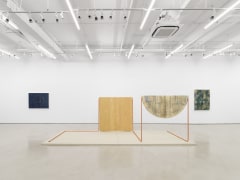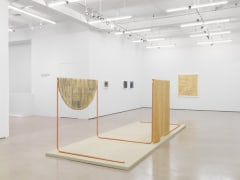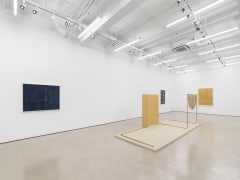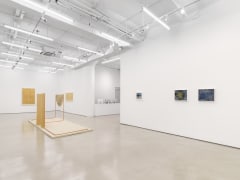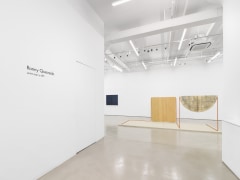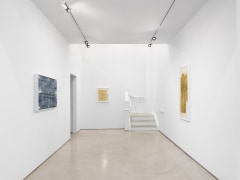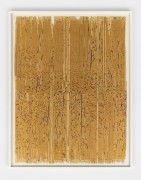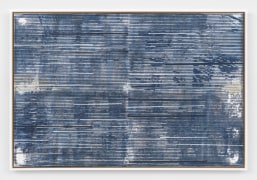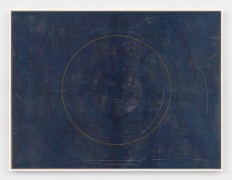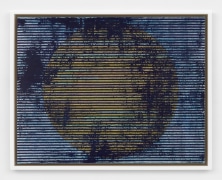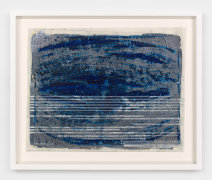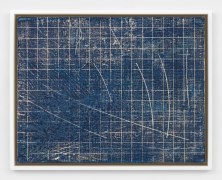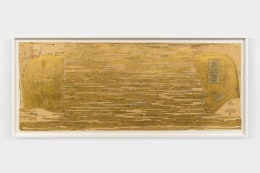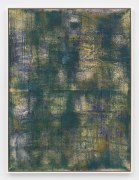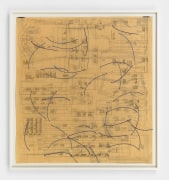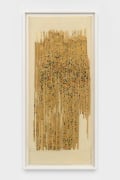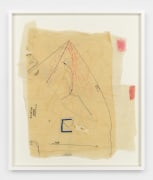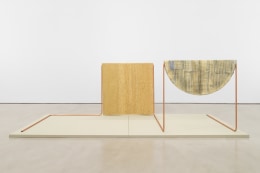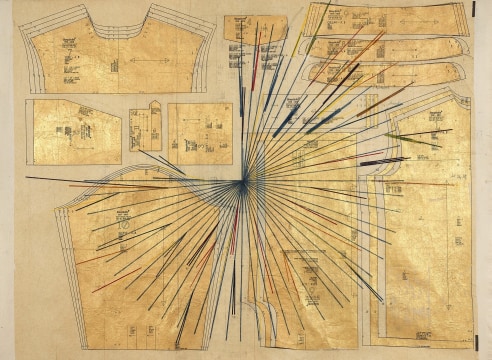
Alexander Gray Associates, New York presents Ronny Quevedo: entre aquí y allá, the Gallery’s first exhibition of the artist’s work. Featuring a new sculpture and works on muslin and paper, entre aquí y allá elaborates on Quevedo’s personal trajectory and interest in cartography and migration. Through compositions that utilize dressmaking materials to abstract the globe, the artist synthesizes alternative forms of mapping. Conflating measurements of the body and of the natural world, this new work delineates metaphorical spaces that embody new identities and approaches to movement.
Quevedo’s understanding of movement is rooted in his biography. He was born in Ecuador, where his father was a professional soccer player. In the 1980s, he immigrated with his family to New York, where his mother began working as a seamstress. In tribute to his mother, Quevedo incorporates pattern paper, wax paper, and muslin into his compositions. As he notes, these materials are “… traditionally used as a way of mapping the body—much like latitude and longitude are used to trace the globe.” Reflective of this tracing and his own immigrant experience, Quevedo writes, “I emphasize the materiality of … [my parents’] histories to engage the places and function of each. I am also interested in how that material culture can represent an expansion of identity and the location of oneself in time and place. This negotiation of who and where is not new.”
Presenting identity as a mutable concept continually informed by location and experience, Quevedo’s works occupy interstitial sites between hemispheres (Northern/Southern) and worlds (pre-colonial/post-colonial, Global North/Global South, etc.). For Quevedo, the iconography of the globe is a “neutral site” where he can explore the seemingly oppositional dichotomies that inform his and other individuals’ identities. Through pieces that emphasize fragmentation and multiplicity like 37th between 6th and 7th (2022), the artist develops a decolonizing visual language that eschews reductive binarisms.
Quevedo notes that this approach is rooted in the Aymar notion of ch’ixi, which the Bolivian sociologist and historian Silvia Rivera Cusicanqui describes as “a dialectic that does not culminate in a synthesis but lives in permanent movement ….” Further underscoring the primacy of “permanent movement,” Quevedo incorporates materials into his work that reference disparate cultures and locales, refuting hierarchical dualisms while centering narratives of migration. Horizon revision (mismeasurement of the periphery) (2022) and other recent pieces juxtapose humble materials like muslin and wax with ostensibly precious ones (gold and silver leaf). Through the use of these elements, Quevedo champions an expansive approach to embodied identity grounded in a plurality that spans indigenous South American cultures and the history of the migrant working class in the United States, a history intertwined with that of communities of color.
Further speaking to this idea, Quevedo’s new sculpture, el guarda meta de los cosmos (from the abyss) (2022), breaks down a grid to suggest a series of portal-like passages, some obscured by draped abstractions. The sculpture invites circumnavigation by constantly reframing these vantage points and reorienting viewers in relation to its structure. (Quevedo deliberately designed its spare frame of copper tubing to suggest indoor soccer goalposts.) Encouraging movement, the piece refutes the idea of a singular, fixed perspective to instead forward multiple.
Ultimately, Quevedo concludes that only by foregrounding this multiplicity is he able to construct “… a space where I can symbolically represent the complex geopolitical movements of immigrant communities and communities of color. This emphasis on shifting boundaries feels political in its acknowledgement that group and individual identities develop in multiple and nuanced ways, rather than simple linear narratives.”
Ronny Quevedo was commissioned by Delta Air Lines in partnership with the Queens Museum to create a large-scale permanent installation at LaGuardia Airport, Queens, NY, for the newly-renovated Terminal C, which opened to the public in 2022. Quevedo’s work has been the subject of numerous one-person exhibitions, including Ronny Quevedo: offside at the University Art Museum, University of Albany, NY (2022); Ronny Quevedo: at the line, Colorado Springs Fine Arts Center, Colorado College, CO (2021); Space of Play, Play of Space, Martin Art Gallery, Muhlenberg College, Allentown, PA (2019); no hay medio tiempo / there is no halftime, Queens Museum, NY (2017), traveled to Temple Contemporary, Tyler School of Art and Architecture, Philadelphia, PA (2019); and Home Field Advantage, Casita Maria Center for Arts & Education, the Bronx, NY (2015). Quevedo has also been included in a number of group exhibitions, including A New Way to Travel: Delta Air Lines x Queens Museum at LaGuardia Airport, Queens Museum, NY (2022); Lux et Veritas, NSU Art Museum, Fort Lauderdale, FL (2022); ReVisión, Denver Art Museum, CO (2021); Comunidades Visibles: The Materiality of Migration, Albright-Knox Art Gallery, Buffalo, NY (2021); Ace: Art on Sports, Promise, and Selfhood, University Art Museum, University of Albany, NY (2019); Pacha, Llacta, Wasichay; Indigenous Space, Modern Architecture, New Art, Whitney Museum of American Art, New York (2018); The World’s Game: Fútbol and Contemporary Art, Perez Art Museum, Miami (2018); Monarchs: Brown and Native Contemporary Artists in the Path of the Butterfly, Bemis Center for Contemporary Art, Omaha, NE (2017), traveled to Museum of Contemporary Art North Miami, FL (2018), Blue Star Contemporary and Southwest School of Art, San Antonio, TX (2018), and The Nerman Museum of Contemporary Art, Overland Park, KS (2019); The Socrates Annual, Socrates Sculpture Park, Queens, NY (2017); Open Sessions: Drawings in Context / Field, Queens Museum, NY (2015); Moving, Not Moving, The McKinney Avenue Contemporary, Dallas, TX (2014); 2014 Core Exhibition, Museum of Fine Arts, Houston, TX (2014); Reading Lists: Artists’ Selections from the MoMA Library Collection, Museum of Modern Art, New York (2013); 2013 Core Exhibition, Museum of Fine Arts, Houston, TX (2013); Eyes Off the Flag, Motus Fort, Tokyo (2012); El Museo’s Bienal: The (S) Files 2011, El Museo del Barrio, New York (2011); and How Soon is Now?, Bronx Museum of the Arts, NY (2008). Quevedo’s work is in the collections of the Albright-Knox Art Gallery, Buffalo, NY; the Colorado Springs Fine Arts Center at Colorado College, CO; the Denver Art Museum, CO; the Museum of Old and New Art, Hobart, Tasmania, Australia; and the Whitney Museum of American Art, New York. He is the recipient of many awards and grants, including the Joan Mitchell Fellowship (2021), the Harpo Foundation New Work Project Grant (2021), the Jerome Hill Artists Fellowship (2019), A Blade of Grass Fellowship for Socially Engaged Art (2017), the Socrates Sculpture Park Artist Fellowship (2017), the Queens Museum / Jerome Foundation Fellowship for Emerging Artists (2016), the Eliza Long Prize, Museum of Fine Arts, Houston (2013, 2014), the New American Paintings MFA Annual 99 (2012), the BRIO Award, the Bronx Council on the Arts (2011), the Gloucester Landscape Painting Prize, Yale School of Art (2011), and the PRINT Magazine Regional Design Annual (2008).



















